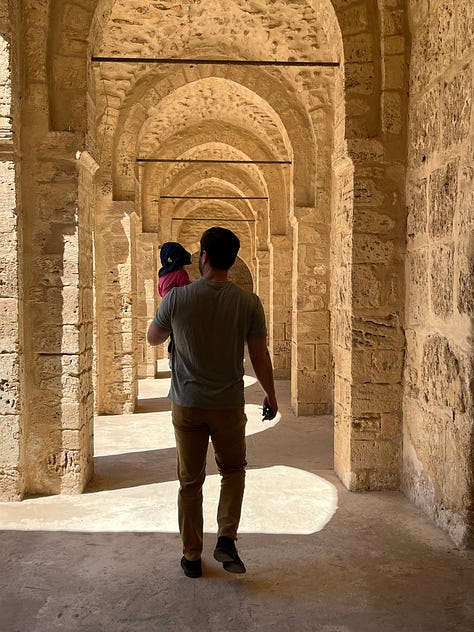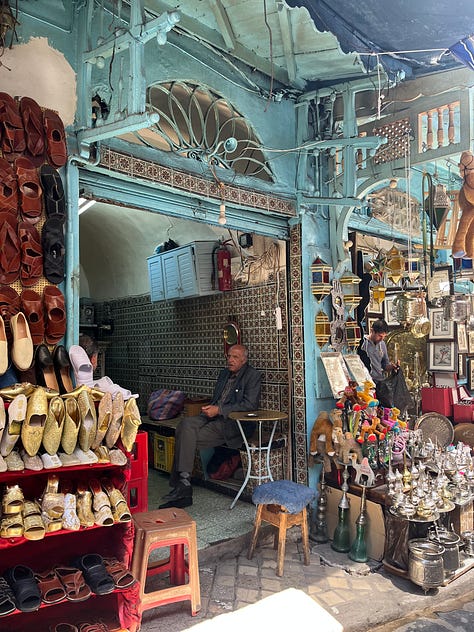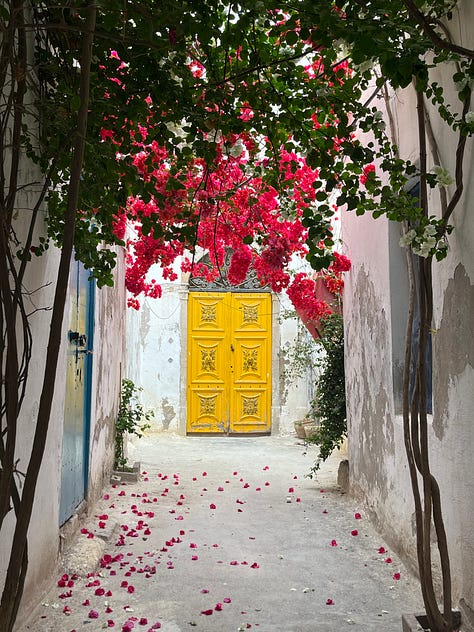Hello hello —
We’re just back from a packed 10 days in Tunisia. Europeans have been visiting Tunisia for ages, but the country has seen an uptick in American visitors lately, potentially due to its inclusion on the NYT ‘where to go’ list in 2019 and other travel media buzz.
Tunisia has a lot going for it, tourism-wise. It’s safe, save for a few areas on the Libya and Algeria borders that most tourists wouldn’t be anywhere near. It’s home to colorful medinas, the ancient Phoenician city of Carthage, as well as the largest collection of Roman mosaics in the world. Plus, you can visit the Atlas Mountains, the Sahara Desert (including where parts of “Star Wars” was filmed), and the Mediterranean Sea.









The French colonized Tunisia from 1881 to 1956, so there’s a strong French influence here (architecture, croissants, patisseries, a large portion of the population speaking French). It’s also extremely close to Italy and there’s a long history of Sicilian immigration to Tunisia (we had really good pizza in Tunis). But many Americans probably first put Tunisia on their radar during the Arab Spring, when the self-immolation of fruit seller Mohamed Bouazizi and ensuing uproar in Tunis kicked off the wave of protests around the region. The protesters were victorious in ousting dictator Zine El Abidine Ben Ali, though over the years authoritarianism has crept back in.
While Tunisia offers a similar travel experience to Morocco, it is far less crowded. That’s partly because of Islamic State terrorist attacks in 2015 that targeted a group of tourists in Sousse and at the Bardo Museum in Tunis, killing 60 people and scaring off tourists. In 2019, seven people were sentenced to life in prison for the attack.
Taxi drivers told us Tunisia had a bad 10 years, with the Arab Spring, Islamic terrorism, and Covid keeping people away. But they’ve seen a surge the past two years. Most tourists come from France, Italy, and Germany.
I was very excited for this trip and am so glad we did it. The Bardo Museum is one of the most stunning museums I’ve ever visited, and I loved walking around the Tunis medina and spending time in the desert. It’s an incredibly beautiful country with a lot to do. That said, it is not the most baby-friendly destination. In some ways, I expected this and was prepared, in others, I was surprised. If your kid is 3 years old or older, I think it would be completely different. Most of the issues are baby specific.
10 Days In Tunisia - Itinerary
We flew from Venice, a quick 80 minute flight. If you’re flying from the U.S. you might add a travel day.
2-3 Days in Sousse: We started the trip in Sousse, a small city on the Gulf of Hammamet. Walk around the medina, walk along the water, eat seafood, climb to the top of the Ribat, and visit the Archaeological Museum. From Sousse, you can take a day trip to Kairouan or El Jem.
2-3 Days in the desert: Next, we flew to Tozeur, gateway to the Sahara. We had one relaxed day at the pool with desert views, and the next day took a day trip to see the Chebika and Tamerza and oases and the Atlas Mountains. This whole section was a highlight!
2 Days in Tunis: In Tunis, you must visit the Bardo Museum. It is absolutely incredible. It has the largest collection of Roman mosaics in the world. They’re so well-preserved and there are so many of them that it’s almost overwhelming. You’ll want to spend a couple of hours here. The other highlights are walking around the medina, shopping, eating street food, and drinking mint tea.
2 Days Sidi Bou Said: You could stay put and do this as a day trip, but I liked the change of location for nightly sunset views. Sidi Bou Said is an adorable hillside town famous for its white and blue buildings. Like Santorini, but much less expensive. From here, visit Carthage, the former capital of the Punic empire. You can do this with a guide or walk around on your own. The Baths of Antoninus were my favorite part. Spend some time in La Marsa and Gammarth, the swankier suburbs of Sidi Bou Said on the beach. Here’s where you’ll find beachfront bars and hotel beach clubs.
Visiting Tunisia with a baby? Here’s what you need to know:
Is it safe? Yes. This is always one of the first things I’m asked whenever traveling outside of Europe. Military operation zones on the border of Algeria and Libya are not safe, but no tourist would be in those areas. There were three terrorist attacks in 2015, which were horrific and scared people away for awhile. Since, there have been random attacks on police officers and security forces. There have been far more terrorist attacks across the U.S.
April is a good time to visit, before the summer high season. Nowhere was crowded and it was warm but not too hot to walk around. (If you’re coming specifically for the beach, it is a little chilly to swim.)
This was the most challenging trip we’ve done with Stella so far. She’s 10 months old and has been to 11 countries and a couple dozen cities, mostly around Europe. Some of the challenges are the same: Tunisia is not stroller friendly, and neither is a lot of Europe. The medinas are basically impossible to walk around with a stroller—hilly, cobblestones, random stairs. This was not a surprise and we packed our trusty Tula Explore carrier for this reason.
The bigger issue was getting around by car. You can walk around Sousse and much of Tunis and Sidi Bou Said, but if you want to see some attractions, you’ll have to take taxis. That’s fine, except that carrying around a car seat is annoying.
Having to take a car seat means you really need to plan ahead. You can’t be out and about in the medina with the carrier and then decide to take a taxi to a museum in another part of town. You have to plan to go somewhere in a taxi and take the car seat and stroller, and then take them back. (Our car seat attaches to our travel stroller–-you don’t need the stroller, but then you have to carry the car seat around your destination, which is much harder than pushing the stroller in my opinion).
Many taxis don’t have seat belts, or have them covered in the back. If you want to ensure you can buckle your car seat in, try calling a “comfort plus” car on Bolt.
When we needed a car seat: to and from the airports; to the Bardo Museum from our hotel in the Tunis medina; to and from Carthage from Sidi Bou Said; from the La Marsa neighborhood back to Sidi Bou Said (we walked there). Carthage was the most annoying, because once there, you can’t really use the stroller, and you definitely don’t want to carry the car seat around.
I should emphasize that this would all be much easier if Stella were even a few months older and no longer in her giant infant car seat. I know travel car seats exist and can be very convenient, but she’s not big enough for those yet. This advice really only applies for babies.
I should also note that Tunisians thought we were crazy. Multiple people (hotel receptionists, etc.) asked us why we were bringing the car seat, because they could tell it would be a huge pain. “It’s close by,” or “the driver will go slow,” they said. Car seats are not widely used in Tunisia, and taxi drivers seemed amused by our insistence on buckling it in. For what it’s worth, with the exception of going to the airport we never drove on a highway, and the rides weren’t long. It probably would have been fine (and much easier) to hold her on our lap, but we didn’t want to risk it. This was something that we knew ahead of time and planned for, but it was still a huge hassle.
There are no high chairs. This is the one that surprised me! Two of the four hotels we stayed in had high chairs for breakfast, but no restaurant we went to did. This seems minor, but combined with not having a stroller most of the time, it actually made the trip much harder. Stella is at the age where she wants to move. She is not going to be chill sitting on our lap for a meal. She is going to want to crawl, climb, lunge herself across the table at every dish. In a high chair or sitting in her stroller, she’s happy. In our laps, even if she’s eating too, she is a little cyclone.
Luckily, sandwiches and wraps are some of the most popular foods in Tunisia. Eating on the go was often easier than going to a restaurant. We also got takeout one night and cooked in our Tunis apartment two nights.
There are very few changing tables. This is also the case in many European and American cities. Lots of floor changes on this mat.
I had heard that Tunisians really love babies, and we found that to be true. People of all ages, from teenage boys to old ladies, waved to Stella, talked to her, tried to make her laugh. Numerous people asked to hold her, and in some cases did so to be helpful during meals. This was all really sweet! Then there was the kissing. Lots of kissing. I had read about this and thought it was probably overblown, but nope. Kissing babies is common, and it can be awkward. Some people would come up and without acknowledging me or Nathan, kiss her feet. Other times, they would kiss her cheeks or nose. The face kisses I was much less comfortable with, mostly because she’s not old enough to have all her vaccines yet. After the first couple of times caught me off guard, I started keeping her farther away, or carried her facing inward in the baby carrier so it was more difficult to reach her face. Of course, you could just be more aggressive and say no, but I am bad at confrontation, worried about offending, and the intention was nice.
Cash is king. Only a few places––bigger hotels, high-end restaurants––take credit cards. Be prepared to pay for everything in cash, even some hotel stays. There are plenty of ATMs.
Taxis are cheap. Like $1-$2 to get across cities. You can flag them, or call them using Bolt (like Uber). It’s a little more expensive to use Bolt, but sometimes easier to have your destination pre-programmed.
It’s not recommended to drink tap water in Tunisia. Adults might be fine, but if your baby drinks formula, use bottled water.
Where we stayed
In Sousse: Dar Badiaa. Cute, family-run guesthouse with a rooftop deck and good breakfast (no high chair). They said they would provide a crib but never did, and the call to prayer, which I normally love, was very loud here and woke Stella up every time. Still, I enjoyed our stay. They also run the restaurant next door, Restaurant Dar el Habib, which was one of the better meals we had.
In Tozeur: Anantara. This was our splurge of the trip, though in off-season it was more affordable than a standard hotel room in most European cities. It bills itself as ultra-luxury. I don’t think it lives up to that, but it is very nice. They have high chairs and cribs.
In Tunis: Dar Ben Turkia. My favorite stay of the trip! A really beautiful, small hotel in the heart of the medina. I liked that the rooms have kitchenettes––so great for washing bottles and having dinner in—yet also felt very much like a hotel, not an Airbnb. The breakfast was very good and a highlight of the trip was hanging out on the hotel’s gorgeous rooftop. They provided a pack-and-play.
In Sidi Bou Said: Dar Said. Another lovely, small hotel with incredible views and a beautiful garden.
What to pack:
About 99% of Tunisia is Muslim. You should dress modestly, but don’t need to cover your hair. In Sidi Bou Said, especially the La Marsa and Gammarth neighborhoods, you can wear whatever you want.
Cash–almost everywhere is cash only, including for large purchases and some hotels.
Sunscreen, sunhat (I love this baby sunhat)
Changing mat and anything else you need to feel comfortable without changing areas (hand sanitizer, etc).
Baby carrier. The hero of the trip!
Are you planning a trip to Tunisia? Drop any specific questions here.
Thanks for reading!
-Rebecca 💛







It’s amazing how much you’ve learned and experienced in just a few days — some locals have never even visited the places you explored. Well done, and don’t hesitate to visit us again!
Thank you so much for sharing about this, even the parts where it was difficult. Part of being a mom is having to learn again from scratch stuff that we knew how to do with two hands tied in the back when we were just us. But that's also part of the motherhood journey and later it will probably bring good laughs to the family when looking back. (I remember this one time where we all got gastro in Czech Republic and we were using Google Translator to talk to the doctor or having to find diapers in Morocco at 23h because we went out despite our planning) lol.
I live in France and have a 5 year old and am now very motivated to visit Tunisia thanks to your article :) I used to follow you already in the past but now that you have a kid and is travelling everywhere with her I'm even more interested in your content. Keep on the good work :D <3